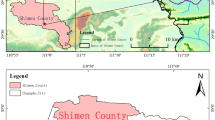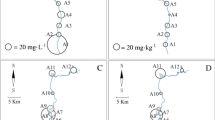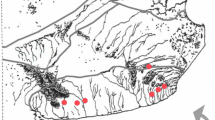Abstract
Mae Moh is a risky area for arsenic contamination caused by the effluent from biowetland ponds in Mae Moh lignite-fuelled power plant. The objective of this study was to investigate the arsenic concentrations of Mae Moh biowetland ponds and determine the main factors which are important for arsenic phytoremediation in the treatment system. The result revealed that arsenic concentrations in the supernant were in the range of less than 1.0 μg As L − 1 to 2.0 μg As L − 1 while those in the sediment were in the range of 25–200 μg As kg soil − 1. Both values were below the Thailand national standard of 0.25 mg As L − 1 for water and 27 mg As kg soil − 1 for the soil. Arsenic accumulation in the biomass of 5 aquatic plants at the biowetland ponds ranged from 123.83 to 280.53 mg As kgPlant − 1. Regarding the result of regression analysis (R 2 = 0.474 to 0.954), high concentrations of organic matter and other soluble ions as well as high pH value in the sediment could significantly enhance the removal of soluble arsenic in the wetland ponds. From the regression equation of accumulated arsenic concentration in each aquatic plant, Eichhornia crassipes (Mart.) Solms. (R 2 = 0.954), Ipomoea aquatica Forsk. (R 2 = 0.850), and Typha angustifolia (L.) (R 2 = 0.841) were found to be preferable arsenic removers for wastewater treatment pond in the condition of low Eh value and high content of solid phase EC and phosphorus. On the other hand, Canna glauca (L.) (R 2 = 0.749) appeared to be favorable arsenic accumulator for the treatment pond in the condition of high Eh value and high concentration of soluble EC.
Similar content being viewed by others
References
American Water Work Association Water Environment Federation (1998). Standard methods for the examination of water and wastewater 20th. New York: American Public Health Association.
Faculty Staff of Department of Soil Science (2005). Introduction of soil science. Department of soil science, agriculture faculty, Kasetsart University, Bangkok. Kasetsart University Press. (in Thai)
Gomez-Caminero, A., Howe, P., Hughes, M., Kenyon, E., Lewis, D. R., Moore, M., et al. (2001). Arsenic and arsenic compounds. Geneva: World Health Organization.
Jason, M. M. (2002). Vertical and seasonal distributions and relationships of Arsenic in Presque Isle sediments. Degree of master of science in environmental studied. Graduate School, Gannon University.
Kabata-Pendias, A., & Pendias, H. (1984). Trace elements in soil and plants. Boca Raton: CRC.
Kramer, U. (2005). Phytoremediation: novel approaches to cleaning up polluted soils. Biotechnology, 16, 133–141.
Mulvaney, R. L. (1996). Nitrogen-inorganic form. In D. L. Sparks, A. L. Page (Ed.), Soil science society of American, Inc, and American society of Agronomy, Inc, Madison: Wisconsin.
Nelson, D. W., & Sommers, L. E. (1982). Total carbon, organic carbon, and organic matter. In A. L. Page, R. H. Miller, D. R. Keeney (Eds.), Methods of soil analysis, part 2. Madison, Wisconsin: American Society of Agronomy.
Notification the Ministry of Science, Technology and Environment, No.3 (1996). Issued under the Enhancement and Conservation of the National Environmental Quality Act B.E. 2535[1992]. published in the Royal Government Gazette, Vol. 113, part 13 D, dated February 13 B.E 2539[1996]. http://www.pcd.go.th/info_serv/en_reg_std_water 04.html#s1. Accessed 2 February 2009.
Notification of Natural Environmental Board, No.25 (2004). Issued under the Enhancement and Conservation of National Environmental Quality Act B.E. 2535[1992]. published in the Royal Government Gazette, No. 121, Special part 119D, dated October 20 B.E. 2547[2004]. http://www.pcd.go.th/info_serv/en_reg_std_soil01.html#s2. Accessed 2 February 2009.
O’Neill, P. (1990). Arsenic in heavy in soils. New York: Blackie.
Permpongsacharoen, W. (1996). The Mae Moh Lignite Mine. Watershed, Vol. 2, No. 2, Nov. 1996 – Feb 1997. http://miningwatch.ca/index.php?/Thailand/The_Mae_Moh_liginte_. Accessed 2 February 2009.
Reeves, R. D., & Baker, A. J. M. (2000). Metal-accumulating plants. In I. Raskin (Ed.), Phytoremediation of toxic metal; Using plants to clean up the environment (pp. 193–229). New York: Wiley.
Rhoades, J. D. (1982). Cation exchange capacity. In A. L. Page, R. H. Miller, D. R. Keeney (Eds.), Methods of soil analysis. Part 2. Madison, Wisconsin: American Society of Agronomy.
Smedley, P. L., & Kinniburgh, D. G. (2002). A review of the source behavior and distribution of arsenic in natural waters. Applied Geochemistry, 17, 517–568. doi:10.1016/S0883-2927(02)00018-5.
Soil and Plant Analysis Council (1999). Soil analysis: Handbook of reference methods. New York: CRC.
Soil Science Society of America Book Series (1996). Method of Soil Analysis Part 3 Chemical Methods. The Soil Science Society of American Book Series No 5. In J.M. Bigham (Ed.), Soil Science Society of American, Inc, and American Society of Agronomy, Inc, Madison: Wisconsin.
Thornton, I., & Farago, M. (1997). The geochemistry of arsenic. In arsenic, exposure and health effects (Compilation of independent studied). London: Chapman & Hall.
Vladimir, N. B., & Kanitta, W. (2002). Environmental fluxes of arsenic from lignite mining and power generation in Northern Thailand. Environmental Geology, 41, 883–888. doi:10.1007/s002540100404.
Author information
Authors and Affiliations
Corresponding author
Rights and permissions
About this article
Cite this article
Nateewattana, J., Trichaiyaporn, S., Saouy, M. et al. Monitoring of arsenic in aquatic plants, water, and sediment of wastewater treatment ponds at the Mae Moh Lignite power plant, Thailand. Environ Monit Assess 165, 585–594 (2010). https://doi.org/10.1007/s10661-009-0970-1
Received:
Accepted:
Published:
Issue Date:
DOI: https://doi.org/10.1007/s10661-009-0970-1




